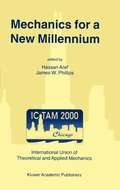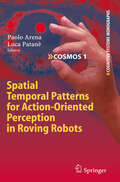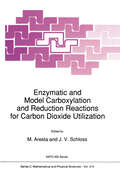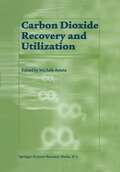- Table View
- List View
Micropropagation of Orchids
by Joseph ArdittiThis greatly expanded and updated edition of a classic reference work comprises two volumes offering a compendium of methods for multiplying orchids through micropropagation. A detailed collection of procedures and methods for multiplying orchids, including organ, tissue, and cell culture techniques in vitro Presents classic techniques that have been in the forefront of orchid propagation since they were first developed in 1949 Detailed procedures are appended with tables and complete recipes for a large number of culture media Includes many illustrations, chemical formulas, historical vignettes, and seldom seen illustrations of people, orchids, apparatus and tools “… an excellent resource like its predecessor, …both informative and captivating, and served as a reminder of why we go to such extremes in our quest to propagate these plants.” American Orchid Society, 2009 “…in the sense of its universal value and importance, this Second Edition will undoubtedly be considered a classic, if only because it will serve as a sole and invaluable resource on the subject.” Plant Science Bulletin, 2009
Liquid Chromatography - Mass Spectrometry: An Introduction (Analytical Techniques in the Sciences (AnTs) *)
by Robert E. ArdreyFirst explaining the basic principles of liquid chromatography and mass spectrometry and then discussing the current applications and practical benefits of LC-MS, along with descriptions of the basic instrumentation, this title will prove to be the indispensable reference source for everyone wishing to use this increasingly important tandem technique. * First book to concentrate on principles of LC-MS * Explains principles of mass spectrometry and chromatography before moving on to LC-MS * Describes instrumental aspects of LC-MS * Discusses current applications of LC-MS and shows benefits of using this technique in practice
Coherence in Spectroscopy and Modern Physics (Nato Science Series B: #37)
by F. T. Arecchi R. BonifacioThis volume contains the lectures and seminars presented at the NATO Advanced Study Institute on "Coherence in Spectroscopy and Modern Physics," the seventh course of the International School of Quantum Electronics, affiliated with the "Ettore Majorana" Centre for Scientific Culture, Erice, Sicily. The Institute was held at Villa LePianore (Lucca), Versilia, Italy, July 17-30, 1977. The International School of Quantum Electronics was started in 1970 with the aim of providing instruction for young researchers and advanced students already engaged in the area of quantum electronics or wishing to switch to this area from a different background. From the outset the School has been under the direction of Prof. F. T. Arecchi, then at the University of Pavia, now at the University of Florence, and Dr. D. Roess of Siemens, Munich. Each year the Directors choose a subject of particular interest, alternating fundamental topics with technological ones, and ask colleagues specifically competent in a given area to take the scientific responsibility for that course.
Instabilities and Chaos in Quantum Optics (Springer Series in Synergetics #34)
by F. Tito Arecchi Robert G. HarrisonOf the variety of nonlinear dynamical systems that exhibit deterministic chaos optical systems both lasers and passive devices provide nearly ideal systems for quantitative investigation due to their simplicity both in construction and in the mathematics that describes them. In view of their growing technical application the understanding, control and possible exploitation of sources of instability in these systems has considerable practical importance. The aim of this volume is to provide a comprehensive coverage of the current understanding of optical instabilities through a series of reviews by leading researchers in the field. The book comprises nine chapters, five on active (laser) systems and four on passive optically bistable systems. Instabilities and chaos in single- (and multi-) mode lasers with homogeneously and broadened gain media are presented and the influence of an injected signal, loss modulation and also feedback of laser output on this behaviour is treated. Both electrically excited and optically pumped gas lasers are considered, and an analysis of dynamical instabilities in the emission from free electron lasers are presented. Instabilities in passive optically bistable systems include a detailed analysis of the global bifurcations and chaos in which transverse effects are accounted for. Experimental verification of degenerative pulsations and chaos in intrinsic bistable systems is described for various optical feedback systems in which atomic and molecular gases and semiconductors are used as the nonlinear media. Results for a hybrid bistable optical system are significant in providing an important test of current understanding of the dynamical behaviour of passive bistable systems.
Antisense RNA Design, Delivery, and Analysis (Methods in Molecular Biology #2434)
by Virginia Arechavala-Gomeza Alejandro GarantoThis open access volume gathers a variety of models, delivery systems, and approaches that can be used to assess RNA technology for exploiting antisense as a therapeutic intervention. Beginning with a section on the design of antisense technology and their delivery, the book continues by covering model systems developed to evaluate efficacy, both in vivo and in vitro, as well as methods to evaluate preclinically the toxicity associated with these new potential drugs, and intellectual property considerations. Written for the highly successful Methods in Molecular Biology series, chapters include introductions to their respective topics, lists of the necessary materials and reagents, step-by-step, readily reproducible laboratory protocols, and tips on troubleshooting and avoiding known pitfalls. Authoritative and practical, Antisense RNA Design, Delivery, and Analysis provides basic knowledge and a large collection of methods to facilitate the work of newcomers to this vibrant and expanding field. This book was conceived thanks to the network DARTER (Delivery of Antisense RNA Therapeutics). DARTER is funded by the EU Cooperation of Science and Technology (COST), which aims to enhance interaction and collaborations between researchers in Europe and other countries.
Mechanics for a New Millennium: Proceedings of the 20th International Congress on Theoretical and Applied Mechanics, held in Chicago, USA, 27 August – 2 September 2000
by Hassan Aref James W. PhillipsThis volume contains the proceedings of the 2000 International Congress of Theoretical and Applied Mechanics. The book captures a snapshot view of the state of the art in the field of mechanics and will be invaluable to engineers and scientists from a variety of disciplines.
Electric Distribution Network Management and Control (Power Systems)
by Ali Arefi Farhad Shahnia Gerard LedwichThis book highlights the recent research advances in the area of operation, management and control of electricity distribution networks. It addresses various aspects of distribution network management, including operation, customer engagement and technology accommodation. Electricity distribution networks are an important part of the power delivery system, and the smart control and management of distribution networks is vital in order to satisfy technical, economic, and customer requirements. A new management philosophy, techniques, and methods are essential to handle uncertainties, security, and stability associated with the integration of renewable-based distributed generation units, demand forecast and customer needs. This book discusses these topics in the context of managing the capacity of distribution networks while addressing the future needs of electricity systems. Furthermore, the efficient and economic operation of distribution networks is an essential part of management of system for effective use of resources, and as such the also addresses operation and control approaches and techniques suitable for future distribution networks.
Organising Post-Disaster Reconstruction Processes: Housing Reconstruction after the Bam Earthquake (The Urban Book Series)
by Fatemeh Farnaz ArefianThrough a synthesis of a broader inter-disciplinary literature in the field of disaster studies, organisation theory and management, and an in-depth case study this book provides an analytical framework for organising post-disaster reconstruction programmes which aim to reduce future disaster risks and achieve other objectives. It explores the role of organisational design and management on approaching and achieving the objectives of the reconstruction programme in Iran after the 2003 Bam earthquake. The housing reconstruction programme in Bam was a complex case, offering various learning opportunities to understand organising reconstruction processes especially in urban areas. The case study research explores how the urban housing reconstruction programme system was formed purposefully towards the delivery of the stated objectives and created an innovative housing process throughout the urban area. It identifies consistencies and inconsistencies among the influential organisational attributes of the programme delivery system formation. The system evolved through corrective adjustments (either formally or informally) during its implementation to reflect unfolding consequences of inconsistencies in initial formation and emerging contextual issues in the field.
Non-Vascular Interventional Radiology of the Abdomen
by Ronald S. ArellanoThis book is designed to provide a foundation for physicians-in-training and a quick guide to further enhance the skills set of practicing interventionalists. It is a concise reference manual covering the major aspects of clinical scenarios, procedures, and techniques. Non-Vascular Interventional Radiology of the Abdomen expertly addresses the planning and execution of commonly encountered procedures, including organ specific biopsies, abscess drainage, urinary interventions, gastrostomy, gastrojejunostomy, and biliary interventions.
Spatial Temporal Patterns for Action-Oriented Perception in Roving Robots (Cognitive Systems Monographs #1)
by Paolo Arena Luca PatanèThe basic principles guiding sensing, perception and action in bio systems seem to rely on highly organised spatial-temporal dynamics. In fact, all biological senses, (visual, hearing, tactile, etc.) process signals coming from different parts distributed in space and also show a complex time evolution. As an example, mammalian retina performs a parallel representation of the visual world embodied into layers, each of which r- resents a particular detail of the scene. These results clearly state that visual perception starts at the level of the retina, and is not related uniquely to the higher brain centres. Although vision remains the most useful sense guiding usual actions, the other senses, ?rst of all hearing but also touch, become essential particularly in cluttered conditions, where visual percepts are somehow obscured by environment conditions. Ef?cient use of hearing can be learnt from acoustic perception in animals/insects, like crickets, that use this ancient sense more than all the others, to perform a vital function, like mating.
Crystal Growth in Science and Technology (Nato Science Series B: #210)
by H. Arend J. HulligerScience and art of crystal growth represent an interdisciplinary activity based on fundamental principles of physics, chemistry and crystallography. Crystal growth has contributed over the years essentially to a widening of knowledge in its basic disciplines and has penetrated practically into all fields of experimental natural sciences. It has acted, more over, in a steadily increasing manner as a link between science and technology as can be seen best, for example, from the achievements in modern microelectronics. The aim of the course "Crystal Growth in Science and Technology" being to stress the interdisciplinary character of the subject, selected fundamental principles are reviewed in the following contributions and cross links between basic and applied aspects are illustrated. It is a very well-known fact that the intensive development of crystal growth has led to a progressive narrowing of interests in highly specialized directions which is in particular harmful to young research scientists. The organizers of the course did sincerely hope that the program would help to broaden up the horizon of the participants. It was equally their wish to contribute within the traditional spirit of the school of crystallography in Erice to the promotion of mutual understanding, personal friendship and future collaboration between all those who were present at the school.
Spezialitäten und Geheimmittel aus den Gebieten der Medizin, Technik Kosmetik und Nahrungsmittelindustrie: Ihre Herkunft und Zusammensetzung
by G. Arends E. Hahn J. HolfertDieser Buchtitel ist Teil des Digitalisierungsprojekts Springer Book Archives mit Publikationen, die seit den Anfängen des Verlags von 1842 erschienen sind. Der Verlag stellt mit diesem Archiv Quellen für die historische wie auch die disziplingeschichtliche Forschung zur Verfügung, die jeweils im historischen Kontext betrachtet werden müssen. Dieser Titel erschien in der Zeit vor 1945 und wird daher in seiner zeittypischen politisch-ideologischen Ausrichtung vom Verlag nicht beworben.
Contaminated Soil '90
by F. Arendt M. Hinsenveld W. J. Van Den BrinkA. Rorsch TNO Board of Management In 1985 the Netherlands Organization for Applied Scientific Research TNO, in cooperation with the Netherlands Ministry for Housing, Physical Planning and the Environment, took the initiative for a conference on an important environmental problem: contaminated soil and groundwater. We named it, somewhat self-assured, the First International TNO Conference on Contaminated Soil. And indeed the contamination of soils and groundwater proved to be an environmental issue of such an extent that soon after the successful first conference, TNO started preparations for a second one, this time in cooperation with the State Ministry for the Environment (Umweltbehorde) of Hamburg. And now we are on the brink of the third conference, organized together with the Karlsruhe Nuclear Research Centre (Kernforschungszentrum Karlsruhe). We feel honoured that the Federal Ministry for Research and Technology (BMFT) is again generously supporting this conference, and has anew declared it a BMFT Status Seminar. The conference (generally referred to as Contaminated Soil '85, Contaminated Soil '88 and Contaminated Soil '90, respectively) has successively gained in importance and prestige, which is reflected by the increasing number of participants and contributions to the scientific programme.
Non-Reflexive Logics, Non-Individuals, and the Philosophy of Quantum Mechanics: Essays in Honour of the Philosophy of Décio Krause (Synthese Library #476)
by Jonas R. B. Arenhart Raoni W. ArroyoThis book discusses the philosophical work of Décio Krause. Non-individuality, as a new metaphysical category, was thought to be strongly supported by quantum mechanics. No one did more to promote this idea than the Brazilian philosopher Décio Krause, whose works on the metaphysics and logic of non-individuality are now widely regarded as part of the consolidated literature on the subject. This volume brings together chapters elaborating on the ideas put forward and defended by Krause, developing them in many different directions, commenting on aspects not completely developed so far, and, more importantly, critically addressing their current formulations and defenses by Krause himself. Given that Krause’s ideas do connect directly and indirectly with a wide array of subjects, such as the philosophy of quantum mechanics, more broadly understood, the philosophy of logic and logical philosophy, non-classical logics, metaphysics, and ontology, this volume contains important material for the research on logic and foundations of science, broadly understood. All the invited contributors have already worked with the ideas developed by Décio (some of them still work with them), being also distinct authors and extremely relevant in their areas of expertise. The volume is aimed at philosophers, including those of physics and quantum mechanics.
Photodisintegration of the Deuteron: A Review of Theory and Experiment (Few-Body Systems #3)
by H. Arenhövel M. SanzoneMore than 50 years ago, in 1934, Chadwick and Goldhaber (ChG 34) published a paper entitled "A 'Nuclear Photo-effect': Disintegration of the Diplon by -y-Rays."l in the introduction: They noted "By analogy with the excitation and ionisation of atoms by light, one might expect that any complex nucleus should be excited or 'ionised', that is, disintegrated, by -y-rays of suitable energy", and furthermore: "Heavy hydrogen was chosen as the element first to be examined, because the diplon has a small mass defect and also because it is the simplest of all nuclear systems and its properties are as important in nuclear theory as the hydrogen is in atomic theory". Almost at the same time, in 1935, the first theoretical paper on the photodisinte gration of the deuteron entitled "Quantum theory of the diplon" by Bethe and Peierls (BeP 35) appeared. It is not without significance that these two papers mark the be ginning of photonuclear physics in general and emphasize in particular the special role the two-body system has played in nuclear physics since then and still plays. A steady flow of experimental and theoretical papers on deuteron photo disintegration and its inverse reaction, n-p capture, shows the continuing interest in this fundamental process (see fig. 1.1).
Organic and Carbon Gels: From Laboratory Synthesis to Applications (Advances in Sol-Gel Derived Materials and Technologies)
by Ana Arenillas J. Angel Menéndez Gudrun Reichenauer Alain Celzard Vanessa Fierro Francisco José Maldonado Hodar Esther Bailόn-Garcia Nathalie JobThis expert volume provides specialized coverage of the current state of the art in carbon gels. Carbon gels represent a promising class of materials with high added value applications and many assets, like the ability to accurately tailor their structure, porosity, and surface composition and easily dope them with numerous species. The ability to obtain them in custom shapes, such as powder, beads, monoliths, or impregnated scaffolds opens the way towards numerous applications, including catalysis, adsorption, and electrochemical energy storage, among others. Nevertheless, it remains a crucial question as to which design synthesis and manufacturing processes are viable from an economic and environmental point of view. The book represents the perspectives of renowned specialists in the field, specially invited to conduct a one-day workshop devoted to carbon gels as part of the 19th International Sol-Gel Conference, SOL-GEL 2017, held on September 3rd, 2017 in Liège, Belgium.Addressing properties and synthesis through applications and industry outlook, this book represents essential reading for advanced graduate students through practicing researchers interested in these exciting materials.
Neural Tracing Methods: Tracing Neurons and Their Connections (Neuromethods #92)
by Benjamin R. ArenkielThis volume seeks to familiarize readers with a diverse range of technologies and approaches for probing neuron and circuit architecture, and, when possible, to attach detailed protocols to help guide readers toward practical application. From classical lipophilic dye and conjugated lectin tracing techniques, to electrophysiological, in vivo imaging, viral tract tracing, and emerging genetic methods to mark, manipulate, and monitor neural circuits, Neural Tracing Methods: Tracing Neurons and Their Connections includes reference to an arsenal of tools and technologies currently being implemented in model systems ranging from flies to mice. Written for the popular Neuromethods series, chapters include the kind of detail and key implementation advice that ensures successful results in the laboratory.Essential and authoritative, Neural Tracing Methods: Tracing Neurons and Their Connections collects a comprehensive compilation of chapters authored by inventors and expert users, that describes state-of-the-art neuronal tracing and functional analysis methods in order to aid researchers in continuing this vital pathway of study.
Advisory Work in Crop Pest and Disease Management (Crop Protection Monographs)
by Z. Arenstein R. Ausher W. Beicht B. D. Blair C. H. Blazquez A. Dinoor I. Dishon G. Edelbaum J. Elkana J. Eshel J. T. Fletcher H. Frankel R. Frisbie K. Hanuss R. Hochberg A. Genizi Y. Golan G. M. McWhorter J. Palti Y. Sachs I. J. Thomason N. C. ToscanoAdvisory work, by its very nature, is an intermediary between the re search worker and those who apply the results of his research. The challenge of advisory work is to devise means of and find pathways for transmitting research results to the user, overcome the reluctance of the latter to change, and often combine novel ideas with well-estab lished traditions. Nowhere is this challenge greater than in farming. This is especially true in developing countries, where the gap in the educational level between research workers and farmers may be ex tremely wide. Moreover, village-level advisers are often overburdened with non-professional functions and are not sufficiently backed up by well-trained professional advisers. Thus, in many of these countries there is a serious discrepancy between the knowledge available and that needed and actually applied on the farm. Advisory work in crop protection is no exception, but profits to some extent from two facts: (1) because of the potentially catastrophic nature of pest attack, governments often operate a supervisory crop protection service, the staff of which may be able to dispense some pest control advice; and (2) the staff of pesticide distributors tends to fill, at least in part, the need for advice on how to fight pests and dis eases with chemicals.
Chemie und Gewinnung der Fette (Advances in Cell Biology)
by Th. Arentz K. Bernhauer J. Brech V. Fischl A. Grün T.P. Hilditch G. Hönnicke S. Ivanow F.E.H. Koch J. Lund S.H. Piper K. Schön H. Schönfeld L. Spirk A. van WerthDieser Buchtitel ist Teil des Digitalisierungsprojekts Springer Book Archives mit Publikationen, die seit den Anfängen des Verlags von 1842 erschienen sind. Der Verlag stellt mit diesem Archiv Quellen für die historische wie auch die disziplingeschichtliche Forschung zur Verfügung, die jeweils im historischen Kontext betrachtet werden müssen. Dieser Titel erschien in der Zeit vor 1945 und wird daher in seiner zeittypischen politisch-ideologischen Ausrichtung vom Verlag nicht beworben.
Carbon Dioxide as a Source of Carbon: Biochemical and Chemical Uses (Nato Science Series C: #206)
by M. Aresta G. FortiProceedings of the NATO Advanced Study Institute, Pugnochiuso, Italy, June 22-July 3, 1986
Enzymatic and Model Carboxylation and Reduction Reactions for Carbon Dioxide Utilization (Nato Science Series C: #314)
by M. Aresta J. V. SchlossThe activation of carbon dioxide by transition metal complexes has been extensively studied. both experimentally and theoretically. 1 Central reactions in this chemistry are the insertion of C02 into M-X bonds. where X = H. C. 0. and N. (eq. 1-4). We are presently investigating the mechanistic aspects of these reaction processes and will herein deSCribe our current level of understanding. Comparisons of the pathway of the carbon-carbon bond fonning process in transition metal chemistry with the well known analogous chemistry involving organolithium reagents will be presented. Furthermore. the role of these reaction types in both homogeneous and heterogenous catalytic processes leading to useful chemicals will be elaborated. _OM> (1) lMt-H + ~ lMlopi _OM> (2) [Mt-R + C0. 2 [M]0. 2CR _OM> (3) [Mt-OR+ ~ [M]0. 2COR _OM> (4) [Mt-NR2 + C0. 2 [M]~CNR2 Insertion of C02 into the Metal-Hydride Bond. The reaction of anionic group 6 (Cr. Mo. W) transition metal hydrides with carbon dioxide to afford metalloformates occurs readlly at ambient temperature and 2 reduced pressures of carbon dioxide. This insertion process is referred to the normal pathway (Scheme 1). There are no documented cases of C02 insertion into the metal hydride bond to provide the alternative. metallocarboxylic acid. isomer (referred in Scheme 1 as abnormal). 3 Recent theoretical studies ascribe this preference to an unfavorable electrostatic interaction and poorer orbital overlap in the latter pro 4 cess. Nevertheless.
Carbon Dioxide as Chemical Feedstock
by Michele ArestaFilling the need for an up-to-date handbook, this ready reference closely investigates the use of CO2 for ureas, enzymes, carbamates, and isocyanates, as well as its use as a solvent, in electrochemistry, biomass utilization and much more. Edited by an internationally renowned and experienced researcher, this is a comprehensive source for every synthetic chemist in academia and industry.
Carbon Dioxide Recovery and Utilization
by Michele ArestaCarbon Dioxide Recovery and Utilization is a complete and informative resource on the carbon dioxide sources and market at the European Union level, with reference to the world situation. The book covers the following themes: - Sources of carbon dioxide and their purity, - Market of carbon dioxide and its uses, - Separation techniques of carbon dioxide from flue gases, - Analysis of the potential of each technique and application, - Basic science and technology of supercritical CO2, - Reactions in supercritical CO2 and its use as reactive solvent, - Utilization of CO2 in the synthesis of chemicals with low energy input, - Conversion of CO2 into fuels: existing techniques, - Dry reforming of methane, - Assessment of the use of carbon dioxide for the synthesis of methanol. This book is unique in providing integrated information and a perspective on innovative technologies for the use of carbon dioxide. The book is suitable for use as a textbook for courses in chemical engineering and chemistry. It is also of great interest as a general reference for those involved with technologies for avoiding carbon dioxide production and for economists. This is an invaluable reference for specialists on synthetic chemistry, gas separation, supercritical fluids, carbon dioxide marketing, renewable energy and sustainable development. In addition, it will be useful for those working in the chemical industry and for policy makers for carbon dioxide mitigation, innovative technologies, carbon recycling, and power generation.
























